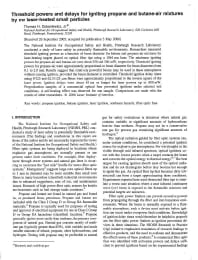Mining Publication: Threshold Powers and Delays for Igniting Propane and Butane-Air Mixtures by CW Laser-heated Small Particles
Original creation date: November 2006
Authors: TH Dubaniewicz
The National Institute for Occupational Safety and Health, Pittsburgh Research Laboratory conducted a study of laser safety in potentially flammable environments. Researchers measured threshold igniting powers as a function of beam diameter for butane and propane-air mixtures by laser-heating targets placed on optical fiber tips using a 1064 nm laser. The minimum igniting powers for propane-air and butane-air were about 250 and 300 mW, respectively. Threshold igniting powers for propane-air were approximately proportional to beam diameter for beam diameters from 0.1 to 2.0 mm. Results suggest that relatively powerful beams may be used in these atmospheres without causing ignition, provided the beam diameter is controlled. Threshold ignition delay times using 9/125 and 62.5/125 um fibers were approximately proportional to the inverse square of the laser power. Ignition delays were about 45 ms or longer for laser powers up to 800 mW. Preproduction samples of a commercial optical fuse prevented ignitions under selected test conditions. A self-healing effect was observed for one sample. Comparisons are made with the results of other researchers.

- Battery Safety Enhancements for Underground Coal Mines
- Further Study of the Intrinsic Safety of Internally Shorted Lithium and Lithium-ion Cells Within Methane-air
- Ignition of Hydraulic Fluid Sprays by Open Flames and Hot Surfaces
- Ignition of Methane-Air Mixtures by Laser Heated Small Particles
- Ignition Tests With a Fiber-Optic Powered Instrument
- Laser Ignition of Flammable Gas
- Lasers
- Methane-Air Mixtures Ignited by CW Laser-Heated Targets on Optical Fiber Tips: Comparison of Targets, Optical Fibers, and Ignition Delays
- Modeling and Data Analysis of 50 to 5000 kHz Radio Wave Propagation in Coal Mines
- Optically Powered Remote Gas Monitor
- Technical Solutions for Enhancements to Mine Safety Using Barricade II Fire Blocking Gel